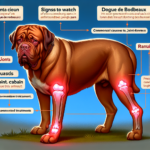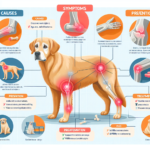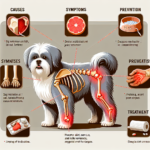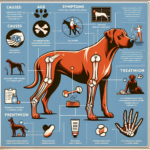Dogue de Bordeaux Joint Pain: Causes, Symptoms, Prevention, and Treatment

Introduction
The Dogue de Bordeaux, also known as the French Mastiff, is a breed with a rich history and distinctive characteristics. Originating in France, this breed was historically used for guarding, hunting, and even pulling carts. Known for their muscular build, large head, and expressive eyes, Dogue de Bordeaux dogs are both powerful and affectionate, making them excellent family companions.
Like many large breeds, the Dogue de Bordeaux is prone to certain health issues, with joint pain being a significant concern. Joint health is crucial for this breed due to their size and weight, which can put extra stress on their joints. Understanding the causes, symptoms, prevention, and treatment of joint pain in Dogue de Bordeaux is essential for ensuring their well-being and quality of life.
Breed-Specific Joint Pain Risks
Genetic Predisposition
The Dogue de Bordeaux is genetically predisposed to several joint-related issues, including hip dysplasia, elbow dysplasia, and arthritis. Hip dysplasia is a condition where the hip joint does not fit properly into the hip socket, leading to pain and mobility issues. Elbow dysplasia involves abnormal development of the elbow joint, causing lameness and discomfort. Arthritis, a degenerative joint disease, can also affect this breed, leading to chronic pain and stiffness.
Age-Related Risks
As the Dogue de Bordeaux ages, the risk of joint pain increases. Typically, signs of joint issues may start to appear in middle age, around 4 to 6 years old. However, some dogs may show symptoms earlier or later, depending on their genetic makeup and lifestyle. It’s important for owners to be vigilant about their dog’s joint health as they age, watching for any signs of discomfort or mobility issues.
Activity Level and Joint Stress
The Dogue de Bordeaux is a relatively active breed, especially when young. Their muscular build and energetic nature can lead to joint stress, particularly if they engage in high-impact activities like jumping or running on hard surfaces. While exercise is important for their overall health, it’s crucial to balance activity levels to avoid overloading their joints.
Common Symptoms of Joint Pain in Dogue de Bordeaux
General Symptoms
- Limping or favoring one leg
- Stiffness, especially after rest
- Reluctance to move or climb stairs
- Decreased activity or playfulness
- Swelling around the joints
- Whining or showing signs of pain when touched
Breed-Specific Symptoms
In the Dogue de Bordeaux, joint pain may manifest more noticeably due to their size and weight. Owners may observe a pronounced limp or difficulty getting up from a lying position. Additionally, the breed’s stoic nature might mean they tolerate pain without obvious signs, so subtle changes in behavior or movement should be taken seriously.
When to Consult a Vet
If you notice any of the above symptoms in your Dogue de Bordeaux, it’s important to consult a veterinarian promptly. Early intervention can help manage pain and slow the progression of joint issues. Regular veterinary check-ups are also essential for monitoring joint health and catching any problems early.
Preventive Measures for Joint Health
Exercise Recommendations
To maintain joint health, it’s important to provide your Dogue de Bordeaux with regular, low-impact exercise. Activities like walking, swimming, and gentle play are ideal. Avoid high-impact exercises such as jumping or running on hard surfaces, which can exacerbate joint stress. Consistent, moderate exercise helps keep muscles strong and supports joint function.
Dietary Suggestions
A balanced diet rich in nutrients that support joint health is crucial for the Dogue de Bordeaux. Look for dog foods that contain glucosamine and chondroitin, which help maintain cartilage health. Omega-3 fatty acids, found in fish oil supplements, can also reduce inflammation and support joint health. Always consult your veterinarian before adding supplements to your dog’s diet.
Weight Management
Maintaining a healthy weight is essential for reducing joint stress in the Dogue de Bordeaux. Excess weight puts additional pressure on the joints, exacerbating pain and mobility issues. Work with your veterinarian to determine the ideal weight for your dog and develop a feeding plan that supports weight management.
Early Screening and Monitoring
Regular veterinary check-ups and early screening for joint issues can help catch problems before they become severe. For the Dogue de Bordeaux, screening for hip and elbow dysplasia is recommended, especially if you plan to breed your dog. Monitoring your dog’s movement and behavior can also help you detect early signs of joint pain.
Treatment Options for Joint Pain
Non-Surgical Treatments
Non-surgical treatments for joint pain in the Dogue de Bordeaux include medications, physical therapy, and lifestyle adjustments. Anti-inflammatory medications and pain relievers can help manage pain and reduce inflammation. Physical therapy, including exercises and massage, can improve mobility and strengthen muscles around the joints. Lifestyle adjustments, such as providing a comfortable bed and avoiding high-impact activities, can also alleviate joint stress.
Surgical Options
In severe cases of joint pain, surgical intervention may be necessary. Common surgeries for joint issues in the Dogue de Bordeaux include hip replacement, elbow surgery, and arthroscopy. These procedures can significantly improve quality of life by reducing pain and restoring mobility. Consult with a veterinary orthopedic specialist to determine the best surgical option for your dog.
Alternative Therapies
Alternative therapies such as acupuncture, hydrotherapy, and massage can also benefit the Dogue de Bordeaux with joint pain. Acupuncture involves inserting thin needles into specific points on the body to relieve pain and improve function. Hydrotherapy, or water therapy, allows dogs to exercise without putting stress on their joints. Massage can help reduce muscle tension and improve circulation, supporting overall joint health.
Lifestyle and Management Tips
Daily Care Routine
A daily care routine for a Dogue de Bordeaux with joint pain should include gentle exercise, a balanced diet, and regular monitoring of their condition. Short, frequent walks and low-impact activities like swimming can help maintain mobility without stressing the joints. Ensure your dog has a comfortable, supportive bed to rest on, and monitor their weight to prevent additional joint stress.
Modifying the Home Environment
Making your home more comfortable for a dog with joint pain can significantly improve their quality of life. Consider adding ramps to help them navigate stairs or get onto furniture. Provide an orthopedic bed that supports their joints and reduces pressure points. Keep their living area free of obstacles to prevent falls and injuries.
Long-Term Management
Long-term management of joint pain in the Dogue de Bordeaux involves regular veterinary check-ups, consistent exercise, and a healthy diet. Work with your veterinarian to develop a comprehensive care plan that includes medications, supplements, and alternative therapies as needed. By staying proactive and attentive to your dog’s needs, you can help them live a comfortable and active life despite joint pain.
FAQs About Dogue de Bordeaux and Joint Pain
What are the early signs of joint pain in a Dogue de Bordeaux?
Early signs of joint pain in a Dogue de Bordeaux include limping, stiffness, reluctance to move, and decreased activity. You may also notice swelling around the joints or changes in behavior, such as increased irritability or reluctance to be touched.
Can joint pain in Dogue de Bordeaux be prevented?
While you can’t completely prevent joint pain, you can take steps to reduce the risk and manage symptoms. Providing a balanced diet, maintaining a healthy weight, and ensuring regular, low-impact exercise can support joint health. Early screening and regular veterinary check-ups are also important for catching issues early.
Are there specific foods that can help with joint health in Dogue de Bordeaux?
Yes, certain foods and supplements can support joint health. Look for dog foods that contain glucosamine, chondroitin, and omega-3 fatty acids. These nutrients help maintain cartilage health and reduce inflammation. Always consult your veterinarian before making changes to your dog’s diet.
When should I consider surgery for my Dogue de Bordeaux’s joint pain?
Surgery should be considered when non-surgical treatments are no longer effective in managing pain and improving mobility. Consult with a veterinary orthopedic specialist to determine the best surgical option for your dog. Common surgeries include hip replacement and elbow surgery.
What alternative therapies are available for managing joint pain in Dogue de Bordeaux?
Alternative therapies such as acupuncture, hydrotherapy, and massage can be beneficial for managing joint pain. These therapies can help reduce pain, improve mobility, and support overall joint health. Consult with your veterinarian to determine the best alternative therapies for your dog.
Conclusion
Joint pain is a significant concern for the Dogue de Bordeaux, but with proper care and attention, you can help manage and alleviate their discomfort. By understanding the causes, symptoms, prevention, and treatment options, you can ensure your dog enjoys a healthy and active life. Regular veterinary check-ups, a balanced diet, and appropriate exercise are key to maintaining joint health. If you notice any signs of joint pain, consult your veterinarian promptly to develop a comprehensive care plan tailored to your dog’s needs.




